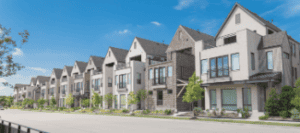Build-to-Rent (BTR) Communities–Coming Soon to an Area Near You!
As the housing market faces a scarcity of available homes, and rental prices soar, both potential homebuyers and renters are finding it increasingly challenging to secure suitable housing. In response, home builders and investors have introduced the concept of “build-to-rent” (BTR) communities, also known as single-family rentals. According to U.S. News, the BTR sector is experiencing a significant surge, with a remarkable 42% growth from one year to the next. Approximately 6% of all housing constructed between September 2021 and September 2022 falls under the build-to-rent category. But what precisely constitutes a build-to-rent community? Why are they essential, and how can your company effectively brand its next BTR community to capitalize on this booming trend?
Defining Build-To-Rent (BTR):

These new multi-family sub-industries offer communities of single-family homes built explicitly for immediate leasing. They operate similarly to apartment communities but with visually distinct phases of delivered units.
Though each home is typically a standalone unit, the BTR community is designed in close proximity, with shared amenities. Unlike vertically stacked apartments, BTR units are spread out, often featuring private outdoor spaces like individual buildings and lawns. Residents enjoy a sense of homeownership while benefiting from the convenience of a traditional multifamily community, complete with abundant amenities and hassle-free maintenance.
TYPES OF BUILD-TO-RENT
The following building types can be classified as build-to-rent communities:
1. Row houses: Built side-by-side, row homes may share a wall.
2. Duplexes: Similar to row houses but with only two attached units.
3. Horizontal apartments: Instead of upward construction, these apartments are built horizontally around a central area.
4. Small lot homes: Single-family homes constructed closely together, often on small lots as small as 600 square feet (compared to typical homes, which may have lots closer to 5,000 square feet).
Is it a Lucrative Investment?
Build-to-rent communities offer numerous advantages for both landlords and residents alike. With an impressive renewal rate of approximately 74%, these standalone units make renovation and issue resolution much easier, as individual units can be addressed without disturbing others. Owners and managers also enjoy easy access to systems, and the spaces are well-suited for turnover, despite it occurring less frequently than in average apartment communities. In some cases, vacant homes can even be repurposed into local cafes or other amenities rather than being rented out again.
Moreover, BTRs can be constructed more quickly than traditional single-family homes, helping to address the lack of affordable housing for those seeking rental options. These faster constructions are generally more favorably received by existing neighborhoods compared to towering apartment complexes that obstruct views and impact parking.
Branding Your Build-to-Rent Communities:
Effective branding is crucial to attract the right residents to your build-to-rent units. Although there aren’t significant differences in branding from typical apartments, paying attention to key nuances can make a significant impact.
1. INDEPENDENCE: Emphasize the sense of independence residents will experience with their own structure, lawn, and address—essentially, it’s like having a home of their own, but with added benefits.
2. ALL THE AMENITIES: Highlight the extensive array of amenities that surpass the offerings of a standard homeowners’ association. From pools to lawn maintenance and home exterior upkeep, BTR communities provide more than just the average suburban living experience.
3. EFFICIENT: Showcase the efficient design that enables on-site management to handle exterior maintenance while residents enjoy their own piece of land.
4. COMMUNITY-ORIENTED: Emphasize the neighborly atmosphere fostered by the community’s layout, promoting a more sociable environment compared to closed-door apartment complexes.
5. AFFORDABLE: Stress the affordability of BTR communities, offering comfort, community, and increased privacy to residents who may not be ready to commit to homeownership.
Staying ahead of the rapidly growing built-to-rent market is crucial. Ensure your branding communicates the direct benefits to potential residents through compelling messaging and imagery.
Source: Multifamily Insiders















 Accessibility
Accessibility